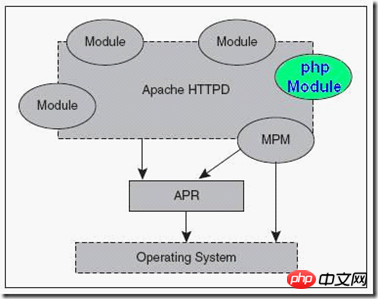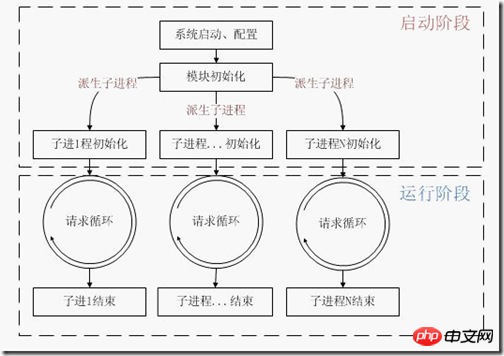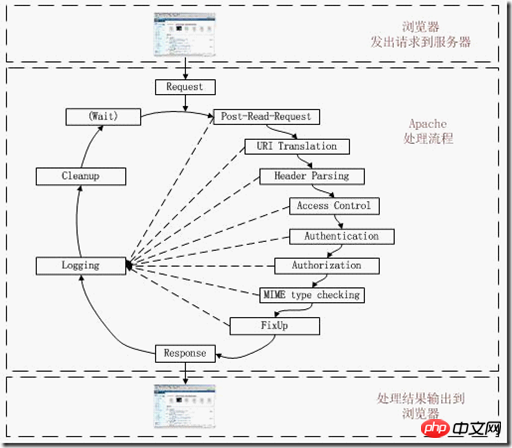The basics of how PHP works
This article mainly introduces the basics of the working principle of PHP. It has a certain reference value. Now I share it with everyone. Friends in need can refer to it.
I recently built a server and suddenly felt like a lamp. How exactly does it work, or how is it connected? I usually just write programs, and I have never thought about the working principle between them:
The underlying working principle of PHP

Figure 1 PHP structure
As can be seen from the picture, PHP is a 4-layer system from bottom to top
①Zend engine
Zend as a whole is implemented in pure C and is the core part of PHP. It combines PHP code with Translation (a series of compilation processes such as lexical and syntax analysis) processes executable opcodes and implements corresponding processing methods, implements basic data structures (such as hashtable, oo), memory allocation and management, and provides corresponding API methods for External calls are the core of everything, and all peripheral functions are implemented around zend.
②Extensions
Around the zend engine, extensions provide various basic services in a component-based manner. Our common various built-in functions (such as array series), standard libraries, etc. are all through extensions To achieve this, users can also implement their own extensions as needed to achieve function expansion, performance optimization and other purposes (for example, the PHP middle layer and rich text parsing currently used by Tieba are typical applications of extensions).
③Sapi
The full name of Sapi is Server Application Programming Interface, which is the server application programming interface. Sapi allows PHP to interact with peripheral data through a series of hook functions. This is PHP's very elegant and A successful design successfully decouples and isolates PHP itself from upper-layer applications through SAPI. PHP can no longer consider how to be compatible with different applications, and the application itself can also implement different processing methods according to its own characteristics. We will introduce it later in the sapi chapter
④Upper-layer application
This is the PHP program we usually write. We can obtain various application modes through different sapi methods, such as implementing web through webserver Apply, run as a script from the command line, etc.
Architectural ideas:
The engine (Zend) component (ext) model reduces internal coupling
The middle layer (sapi) isolates the web server and php
************************************************ ****************************
If php was a car, then
The framework of the car is php itself
Zend is the engine of the car
The various components below Ext are the wheels of the car
Sapi can be regarded as a road, a car It can run on different types of roads
And the execution of a php program means the car runs on the road.
Therefore, we need: an engine with excellent performance, a suitable wheel, a correct runway
The relationship between Apache and php
Apache’s analysis of php, It is accomplished through the php Module among many Modules.

To finally integrate php into the Apache system, you need to make some necessary settings for Apache. Here, we will take the mod_php5 SAPI operating mode of php as an example to explain. As for the concept of SAPI, we will explain it in detail later.
Assume that the versions we install are Apache2 and Php5, then you need to edit Apache’s main configuration file http.conf and add the following lines to it:
In Unix/Linux environment:
LoadModule php5_module modules/mod_php5.so
AddType application/x-httpd-php .php
Note: modules/mod_php5.so is mod_php5.so in the X system environment The location where the file is installed.
In Windows environment:
LoadModule php5_module d:/php/php5apache2.dll
AddType application/x-httpd-php .php
Note: Among them, d:/php/php5apache2.dll is the installation location of the php5apache2.dll file in the Windows environment.
These two configurations tell Apache Server that any Url user requests received in the future with php as the suffix need to call the php5_module module (mod_php5.so/php5apache2.dll) for processing.
Apache’s life cycle

Apache’s request processing process

Apache request Detailed explanation of processing loop
What are done in the 11 stages of Apache request processing loop?
1. Post-Read-Request stage
In the normal request processing process, this is the first stage where the module can insert hooks. This stage can be exploited for modules that want to get into processing requests very early.
2. URI Translation Phase
The main work of Apache in this phase: mapping the requested URL to the local file system. Modules can insert hooks at this stage to execute their own mapping logic. mod_alias uses this phase to work.
3. Header Parsing Phase
The main work of Apache in this phase: Check the header of the request. Since the module can perform the task of checking request headers at any point in the request processing flow, this hook is rarely used. mod_setenvif uses this phase to work.
4. Access Control Phase
The main work of Apache in this phase: Check whether access to the requested resource is allowed according to the configuration file. Apache's standard logic implements allow and deny directives. mod_authz_host uses this phase to work.
5. Authentication stage
The main work of Apache in this stage is to authenticate users according to the policies set in the configuration file and set the user name area. Modules can insert hooks at this stage to implement an authentication method.
6. Authorization stage
The main work of Apache in this stage is to check whether authenticated users are allowed to perform the requested operation according to the configuration file. The module can insert hooks at this stage to implement a user rights management method.
7. MIME Type Checking Phase
The main work of Apache in this phase is to determine the content processing function to be used based on the relevant rules of the MIME type of the requested resource. The standard modules mod_negotiation and mod_mime implement this hook.
8. FixUp stage
This is a general stage that allows the module to run any necessary processing before the content generator. Similar to Post_Read_Request, this is a hook that can capture any information and is also the most commonly used hook.
9. Response stage
The main work of Apache in this stage is to generate content returned to the client and be responsible for sending an appropriate reply to the client. This stage is the core part of the entire process.
10. Logging stage
The main work of Apache in this stage: recording the transaction after the reply has been sent to the client. Modules may modify or replace Apache's standard logging.
11. CleanUp Phase
The main work of Apache in this phase: clean up the environment left after the completion of this request transaction, such as the processing of files and directories or the closing of Socket, etc. This is the first time for Apache The final stage of request processing.
LAMP architecture:

Four layers from bottom to top:
①liunx belongs to the bottom layer of the operating system
②apache server, belongs to the secondary server, communicates with Linux and PHP
③php: belongs to the server-side programming language, and is associated with apache through the php_module module
④Mysql and other web services: belong to the application Service, associated with mysql through PHP's Extensions plug-in module
Android system architecture diagram
Compare lamp and Android's architecture diagram, it seems to be somewhat similar to lamp architecture, I I don’t understand Android, but it feels a bit similar. Experts can point out the differences. I would be very grateful.

From top to bottom:
Android architecture-- ------------Description--------LAMP architecture
1. Application--------Specific application------- -web application
2. Application framework----java-------------PHP language and library
3. System runtime library:-- --Virtual machine---------WEB server
⒋Linux kernel:---Operating system------L
in lamp architecture The relationship between the lamp and the inside of the computer
The CPU is the factory, the hard disk is the large warehouse, the memory is the regular transfer center, and the virtual memory is the temporary transfer center
Php language is compiled into machine language by zend , operating cpu
The operation of the database is an I/O operation and a mechanical movement. In other words, the bottleneck of a website is caused by reading and writing to the hard disk. The solution is to reduce the number of I/O operations. The use of buffering technology means that the data operations are placed in the mencache, and when it reaches a certain order of magnitude, it is written to the database at once. The mencache belongs to the key--value relationship
rather than relational data. It is also built based on this concept. , also belongs to the key--value relationship
Frequent read operations------Put it in mencache
Read more and write less----Put it in nosql----- -The reading function is very powerful!
The above is the entire content of this article. I hope it will be helpful to everyone's study. For more related content, please pay attention to the PHP Chinese website!
Related recommendations:
PHP source code differentiation platform MVC structure introduction
Analysis of Laravel5 quick authentication logic process
The above is the detailed content of The basics of how PHP works. For more information, please follow other related articles on the PHP Chinese website!

Hot AI Tools

Undresser.AI Undress
AI-powered app for creating realistic nude photos

AI Clothes Remover
Online AI tool for removing clothes from photos.

Undress AI Tool
Undress images for free

Clothoff.io
AI clothes remover

Video Face Swap
Swap faces in any video effortlessly with our completely free AI face swap tool!

Hot Article

Hot Tools

Notepad++7.3.1
Easy-to-use and free code editor

SublimeText3 Chinese version
Chinese version, very easy to use

Zend Studio 13.0.1
Powerful PHP integrated development environment

Dreamweaver CS6
Visual web development tools

SublimeText3 Mac version
God-level code editing software (SublimeText3)

Hot Topics
 Alipay PHP SDK transfer error: How to solve the problem of 'Cannot declare class SignData'?
Apr 01, 2025 am 07:21 AM
Alipay PHP SDK transfer error: How to solve the problem of 'Cannot declare class SignData'?
Apr 01, 2025 am 07:21 AM
Alipay PHP...
 Explain JSON Web Tokens (JWT) and their use case in PHP APIs.
Apr 05, 2025 am 12:04 AM
Explain JSON Web Tokens (JWT) and their use case in PHP APIs.
Apr 05, 2025 am 12:04 AM
JWT is an open standard based on JSON, used to securely transmit information between parties, mainly for identity authentication and information exchange. 1. JWT consists of three parts: Header, Payload and Signature. 2. The working principle of JWT includes three steps: generating JWT, verifying JWT and parsing Payload. 3. When using JWT for authentication in PHP, JWT can be generated and verified, and user role and permission information can be included in advanced usage. 4. Common errors include signature verification failure, token expiration, and payload oversized. Debugging skills include using debugging tools and logging. 5. Performance optimization and best practices include using appropriate signature algorithms, setting validity periods reasonably,
 How does session hijacking work and how can you mitigate it in PHP?
Apr 06, 2025 am 12:02 AM
How does session hijacking work and how can you mitigate it in PHP?
Apr 06, 2025 am 12:02 AM
Session hijacking can be achieved through the following steps: 1. Obtain the session ID, 2. Use the session ID, 3. Keep the session active. The methods to prevent session hijacking in PHP include: 1. Use the session_regenerate_id() function to regenerate the session ID, 2. Store session data through the database, 3. Ensure that all session data is transmitted through HTTPS.
 How to debug CLI mode in PHPStorm?
Apr 01, 2025 pm 02:57 PM
How to debug CLI mode in PHPStorm?
Apr 01, 2025 pm 02:57 PM
How to debug CLI mode in PHPStorm? When developing with PHPStorm, sometimes we need to debug PHP in command line interface (CLI) mode...
 Describe the SOLID principles and how they apply to PHP development.
Apr 03, 2025 am 12:04 AM
Describe the SOLID principles and how they apply to PHP development.
Apr 03, 2025 am 12:04 AM
The application of SOLID principle in PHP development includes: 1. Single responsibility principle (SRP): Each class is responsible for only one function. 2. Open and close principle (OCP): Changes are achieved through extension rather than modification. 3. Lisch's Substitution Principle (LSP): Subclasses can replace base classes without affecting program accuracy. 4. Interface isolation principle (ISP): Use fine-grained interfaces to avoid dependencies and unused methods. 5. Dependency inversion principle (DIP): High and low-level modules rely on abstraction and are implemented through dependency injection.
 How to automatically set permissions of unixsocket after system restart?
Mar 31, 2025 pm 11:54 PM
How to automatically set permissions of unixsocket after system restart?
Mar 31, 2025 pm 11:54 PM
How to automatically set the permissions of unixsocket after the system restarts. Every time the system restarts, we need to execute the following command to modify the permissions of unixsocket: sudo...
 Explain late static binding in PHP (static::).
Apr 03, 2025 am 12:04 AM
Explain late static binding in PHP (static::).
Apr 03, 2025 am 12:04 AM
Static binding (static::) implements late static binding (LSB) in PHP, allowing calling classes to be referenced in static contexts rather than defining classes. 1) The parsing process is performed at runtime, 2) Look up the call class in the inheritance relationship, 3) It may bring performance overhead.
 How to send a POST request containing JSON data using PHP's cURL library?
Apr 01, 2025 pm 03:12 PM
How to send a POST request containing JSON data using PHP's cURL library?
Apr 01, 2025 pm 03:12 PM
Sending JSON data using PHP's cURL library In PHP development, it is often necessary to interact with external APIs. One of the common ways is to use cURL library to send POST�...






